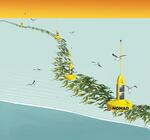
An artist's rendering of a project that could grow kelp used for biofuel in the open ocean -- that seaweed could one day power your car.
Courtesy of Pacific Northwest National Laboratory
There’s a new type of biofuel in the works — and it could one day reduce the use of fertilizers, farming land, and power your car. Northwest researchers are looking to seaweed as the next big thing in biofuel.
Scientists at Pacific Northwest National Laboratory have a big plan for growing seaweed in the open ocean.
“The open ocean covers 70 percent of the world’s surface area but provides only 1 percent of the world’s food (or biomass) supplies. So clearly there is a massive frontier out there that could be explored for growing biomass and not competing with biomass production for food,” said Michael Huesemann, an engineer at at Pacific Northwest National Laboratory based in Sequim, Washington.
Huesemann has an idea that’s never been tried: free floating seaweed cultivation.
But first there’s a lot of research that needs to happen. Researchers just received funding to develop a thorough plan for the project.
Huesemann has a vision, though.
Kelp would grow on long, recycled cables, floating from Washington to California for up to six months. The floating part is a big deal, he said.
About 30 years ago researchers tried to grow kelp, also called macroalgae, on anchored systems off the Southern California coast.
“When the first major storm came, everything was lost, and they couldn’t find anything,” Huesemann said. “So people got burned and didn’t really want to look at marcroalgae again.”
A free-floating system, he said, wouldn’t be destroyed in storms. It would flow with nutrient-rich currents.
A ship in Washington would release 5-kilometer carbon fiber cables seeded with two types of kelp — that’s 3.1 miles long. The ship would release cable after cable. Each would be outfitted with sensors and buoys to help locate the seaweed in the United State’s Marine Exclusive Economic Zone, where the U.S. has sovereign rights for economic exploration and exploitation. The zone makes up an area larger than the land mass of all 50 states, Huesemann said.
“So if you were to look from a satellite from the top, you would see all these different ropes on a current, maybe hundreds, floating along (the ocean current),” Huesemann said.
This project was awarded $500,000 from the Department of Energy’s Advanced Research Projects Agency-Energy. Because it is such an untested idea, the funding will last for one year as researchers design the project — and work out potential kinks like fish eating too much of the kelp or how to maneuver through shipping channels.
In a year, if they’re successful, they could receive additional funding for pilot projects that would be tested in Sequim Bay and on the Strait of Juan de Fuca.
The cable materials would help cut costs. They'd be recycled from composite waste materials from the aviation industry. Huesemann estimates they'd be six times less expensive than commercial seaweed cables and would last 20 years.
One requirement of the grant is that the technology greatly reduces the cost of growing kelp, making it about 3 times less expensive than what it costs to grow seaweed commercially right now. (Seaweed is most often grown for food today.) The industry is very labor and capital intensive, Huesemann said.
For this project, Huesemann envisions the harvesting and seeding systems to be autonomous, which would make growing seaweed cheaper.
About 5 percent of the U.S. transportation energy demand is supplied by bioenergy, Huesemann said.
One of the biggest forms of biofuel right now is ethanol, which is made from corn. Kelp has almost double the yield of corn per hectare, he said.
Kelp would be at an advantage because it wouldn’t be using land that’s needed for other agricultural purposes, he said. It also wouldn’t need synthetic fertilizers.
He also thinks it would provide benefits to the ocean and its sea life: nutrients and housing for fish, for one.
To get all this system up and running, one big question is how ocean conditions will affect seaweed cultivation.
Another key project from PNNL received funding to model the best spots and times to grow seaweed in the open ocean.
It’d be a big component: knowing when and where to release kelp into the open ocean.
PNNL scientist Zhaoqing Yang is leading a project, which was awarded more than $2 million, to help develop computer modeling for open ocean seaweed cultivation.
His project, which could work en tandem with Huesemann’s effort, will look at seaweed growth. It would take into account many variables from nutrients availability to ocean conditions like waves and storm surges.
The goal would be that his models could be used on the East and West coasts for free floating or anchored kelp farms.
“We need to know the risk of the (cultivation) deployment,” Yang said. “If you had a location that was subject to, for example, hurricanes or a large wave in the Pacific Northwest. Our modeling tools will be able to provide critical information to support the system’s survival and risk analysis.”
They’ll model numerous variables and identify the optimal places to grow kelp, Yang said. Free floating designs will be especially challenging, he said, because of all the different places they will pass through.
“If we can successfully deploy the free-floating system, that will definitely put the U.S. in the lead in terms of large-scale macroalgae growth,” Yang said.
